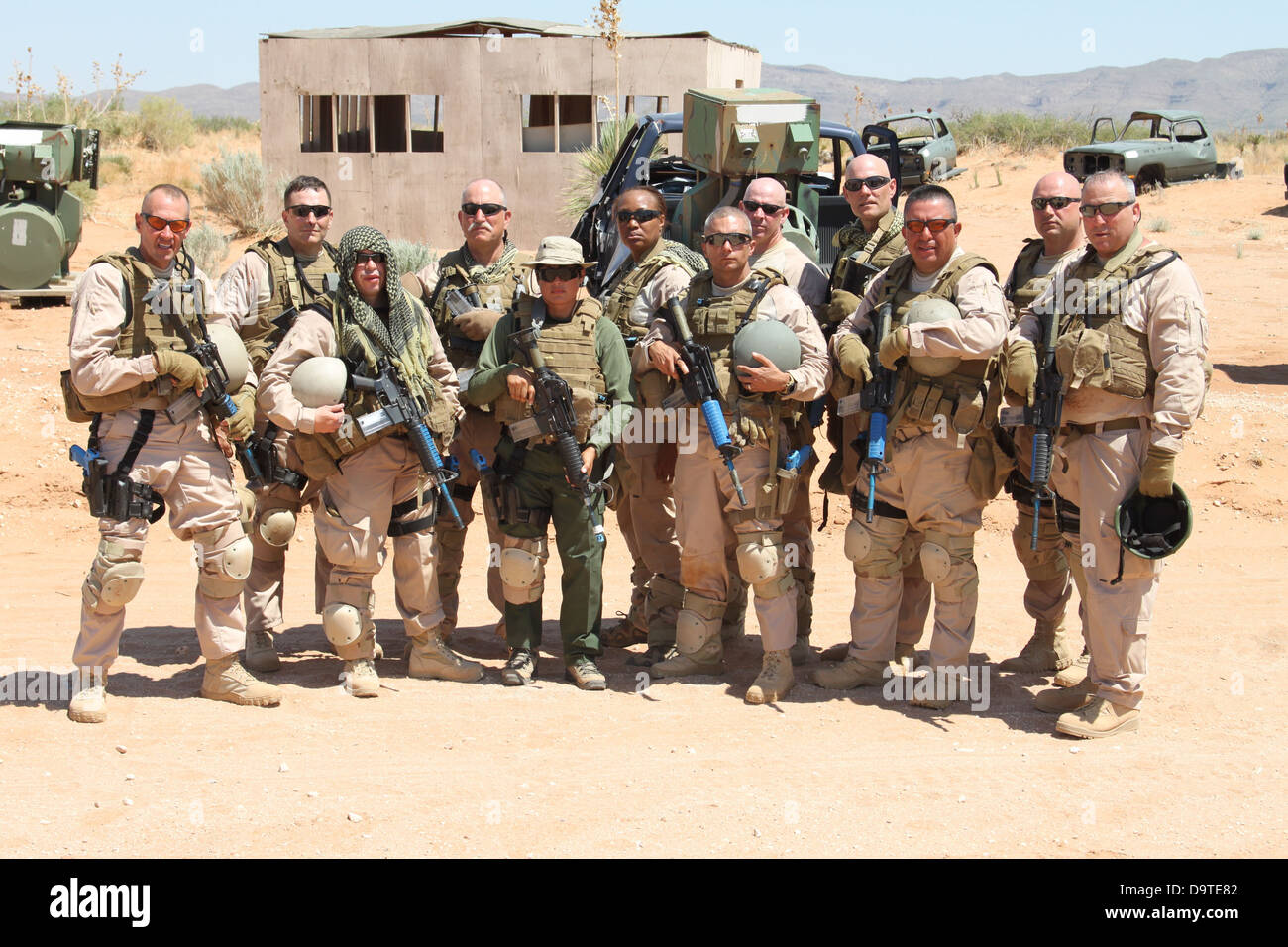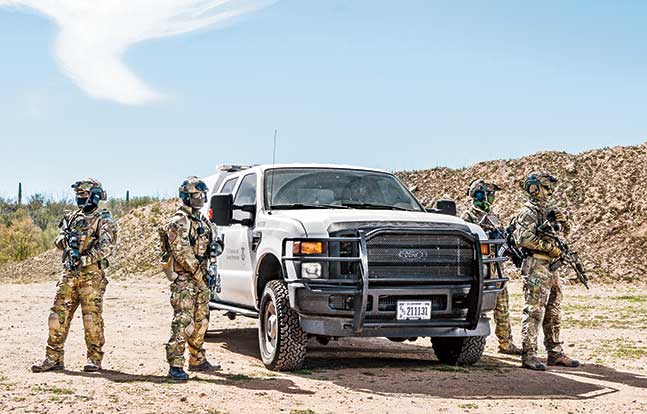Bortac Training Course
The U.S. Border Patrol Tactical Unit, or BORTAC, was established in 1984, which makes the unit one of the oldest law enforcement tactical teams in the U.S. BORTAC is also one of the most active and diversified tactical units in the law enforcement profession.
- RELATED: BORTAC Adopts the Heckler & Koch P30L
In addition to serving as the Special Operations Group (SOG) headquarters for the U.S. Border Patrol, Biggs Army Airfield in El Paso, Texas, also serves as the national BORTAC operations and training center. The national BORTAC command has administrative responsibilities over sector BORTAC units stationed along the southwest border and in certain areas along the northern border. These responsibilities include training and equipping the sector teams as well as developing and implementing policy and standard operating procedures. Additionally, SOG has full-time BORTAC operational sections responsible for response capabilities anywhere in the United States as well as missions overseas.
- Brian Terry in BORTAC training -- In his honor.
- 1) Which selection course is physically harder to pass? 2) Which group are. Pretty informative as to thier selection and training.
Intense, sport-specific 8-week program is specifically designed to prepare athletes for the US Border Patrol's BORTAC Selection.
Core Missions
In order to perform their wide array of missions, BORTAC currently maintains a strength of some 200 active agents. BORTAC missions include counterterrorism, drug interdiction and other operations that involve protecting the national security of the United States. BORTAC’s core missions include direct action, foreign internal defense, special national security events, security assistance and special reconnaissance.
Direct action missions are short term in nature and usually involve high-risk tactical operations, border violence, drug interdictions and counter-terrorist operations. Security assistance missions involve performing threat assessments, protection details and other security duties. When they perform special reconnaissance missions, BORTAC agents gather intelligence through various means for the purposes of further identifying and stopping major violators who are involved in acts of smuggling and other criminal activities.
As mentioned, BORTAC operators provide security and other assistance as required at high-profile events, major natural disasters—including Hurricanes Katrina and Rita in 2005—and certain political events. Some examples of BORTAC national security missions include the Summer Olympics in Los Angeles (1992), the World Games in Buffalo (1993), the Winter Olympics in Salt Lake City (2002), international airport security details during Operation Desert Storm (1990-1991) and security details at ports of entry in 1994 and 1995. BORTAC agents also responded to the Atlanta, Georgia, federal penitentiary riots as well as to acts of civil unrest at various federal immigration detention facilities. In 2000 and 2002, BORTAC agents performed security details at the World Trade Organization meeting and the G8 Summit in Canada.
While conducting foreign internal defense missions, BORTAC agents assess the capabilities of the host (foreign) nation while also providing training to host government personnel. To date, BORTAC agents have conducted foreign internal defense missions in Colombia, Panama, Estonia, Haiti, Peru, Belize, Mexico, Costa Rica, Kenya, the Ukraine, Kosovo, Argentina, Honduras, Ecuador, Bolivia, Moldova, Ethiopia, Armenia, Tajikistan and Guatemala. This includes serving in Operation Cadence from 1992 to 1995 and Operation Snowcap from 1987 to 1995. During the Global War on Terror, U.S. BORTAC agents have also served in Jordon, Iraq and Afghanistan.
Iraqi Freedom
During the Global War on Terror, various federal law enforcement agencies deployed armed personnel to Iraq and Afghanistan to perform a variety of missions. Serving with distinction in Iraq were U.S. Customs and Border Protection officers, U.S. Border Patrol agents and BORTAC agents.
From 2005 to 2007, BORTAC agents served in Iraq as members of Mobile Training Teams. In addition to training Iraqi Border Police, BORTAC agents also served as advisors and worked beside Iraqi Border Police officers in the field. From 2008 to 2011, BORTAC agents served as members of the Department of Defense Security Transition Teams in Iraq. BORTAC agents also trained the Iraqi Border Police tactical team as well as Iraqi Border Police officers and managers.
During their service in Iraq, BORTAC agents served in Baghdad, Al-Waleed, Al-Qaim,Trebil, Zurbatiya, Muntheria and Umm Qasr. Clearly, this was a critical mission because the Iraqi Border Police are responsible for preventing smugglers, insurgents, weapons or the money needed to fund terrorist organizations from entering their country.
Making The Cut
Both the screening program to qualify for BORTAC training and the actual training course is one of the most demanding in the law enforcement profession. The requirements to become a BORTAC agent include a minimum of two years in service as a Border Patrol agent, the successful completion of the physical abilities test, establishing proficiency with firearms as well as the successful completion of the five-week BORTAC Basic Selection and Training Course. The current attrition rate for BORTAC training is around 70 percent.
As sworn federal law enforcement officers, U.S. Border Patrol BORTAC agents are authorized to carry firearms on and off duty. When participating in high-risk missions here and abroad (with host nations and the U.S. Embassy’s approval) BORTAC agents are also authorized to carry an issued M4 Carbine and various other special weapons and equipment. Tactical Weapons salutes BORTAC agents for their outstanding service to our nation, which includes securing our borders and assisting allied and coalition nations in performing their border security missions.
Jump to navigationJump to searchBORTAC is an initialism for the United States 'Border Patrol Tactical Unit'. BORTAC is the tactical/special response arm of the United States Border Patrol.
| BORTAC | |
|---|---|
| Agency overview | |
| Formed | 1984 |
| Jurisdictional structure | |
| Federal agency | United States |
| Operations jurisdiction | United States |
| General nature | |
| Headquarters | Biggs Army Airfield, Fort Bliss in El Paso, Texas |
| Parent agency | U.S. Border Patrol |
Mission[edit]
The mission of BORTAC is 'to respond to terrorist threats of all types anywhere in the world in order to protect our nation’s homeland.' [1]
History[edit]
The unit was first formed in 1984 to deal with disturbances occurring within Immigration and Naturalization Service detention facilities, but this mission is now handled by the U.S. Immigration & Customs Enforcement (ICE), Enforcement & Removal Operations (ERO), Special Response Teams (SRT). Since its inception BORTAC has steadily expanded its scope and mission capabilities, and is now a rapid response unit capable of executing both foreign and national level domestic operations. BORTAC members have operated in 28 countries around the world. Missions have included international training/advisory functions, counter terrorism operations, counter narcotics operations, high-risk warrant service, dignitary protection, interdiction & patrol operations, and tactical training to other U.S. agencies and military units.[1]
Organization[edit]
BORTAC headquarters is co-located with its training unit at Biggs Army Airfield, within Fort Bliss U.S. Army base in El Paso, Texas. The BORTAC training unit is currently responsible for conducting all CBP tactical team training. In addition, the unit also provides specialist training to other Federal, state and local law enforcement agencies. As part of a joint Department of State/ Department of Justice training program, BORTAC has also provided tactical team and counter narcotics training to several foreign governments police, paramilitary, tactical, drug, and specialist units, including the El Salvador National Police's Grupo de Respuesta Policial (GRP) tactical unit.
Equipment[edit]
BORTAC is authorized a wide range of weapons systems such as:
Commview for wifi vs wireshark. Since CommView intercepts packets before they reach the network adapter, the checksum appears to be incorrect.
- Heckler & Koch P2000 pistol, in .40 S&W, with the LEM (Law Enforcement Mechanism) double-action trigger system
- Heckler & Koch USP Compact pistol in .40 S&W
- Heckler & Koch P30L LEM in .40 S&W
- HK UMP submachine gun in .40 S&W
- Remington 870 12 gauge shotgun with 14' barrel, specially modified by Scattergun Technologies
- M4A1 carbine in 5.56×45mm
- M14 rifle in .308 Winchester
- SIG Sauer P229 DAO in 9×19mm Parabellum
- Remington 700 .308 rifle
- M40 rifle XBKS .308 rifle
- Heckler & Koch MP5 (being phased out)
- Heckler & Koch HK53 A2 or A3
- Steyr SSG rifle.
Bortac Training
Uniforms[edit]
When conducting operations BORTAC personnel normally wear OG-107 uniforms, or sage green flight suits with a subdued Border Patrol patch sewn on. Each team member is also equipped with a Kevlar ballistic helmet and a Kevlar assault vest. Boots worn by individual team members depend on the operator's personal preference and situation.
Operations[edit]
During the 1980s War on Drugs, BORTAC worked with the Drug Enforcement Administration conducting counter narcotics operations in South America during Operation Snowcap.[2]

Bortac Tracking Course
In April 2000, the BORTAC conducted Operation “Reunion,” in which it executed a raid on a home in Miami, Florida, and safely returned Cuban refugee Elian Gonzalez to his family in Cuba.[2]
Where is the serial number on a vitamix. Following the World Trade Center Attack in September 2001, BORTAC personnel were sent to high-risk areas around the country to help secure against future attacks.[2]
In 2002, BORTAC worked jointly with the United States Secret Service securing sports venues at the Salt Lake City Winter Olympic Games.[2]
Recent natural disasters have vaulted BORTAC personnel into tactical relief operations (TRO) by providing hurricane relief aid to Gulf Coast residents and law enforcement support to law enforcement agencies affected by Hurricane Katrina.[2]
In December 2010, BORTAC Agent Brian Terry was killed while pursuing members of a gang that operated along the border of Mexico and Arizona.[3]
See also[edit]
- Border Patrol, Search, Trauma and Rescue (BORSTAR)
Bortac

References[edit]
- ^ abhttp://www.cbp.gov/xp/cgov/border_security/border_patrol/special_oper/bortac/bortac_unit.xml
- ^ abcdehttp://www.cbp.gov/xp/CustomsToday/2006/may/tactical_unit.xml
- ^'Napolitano confirms gang killed border agent in battle - USATODAY.com'.
External links[edit]
- Official website Fact Sheet (PDF)